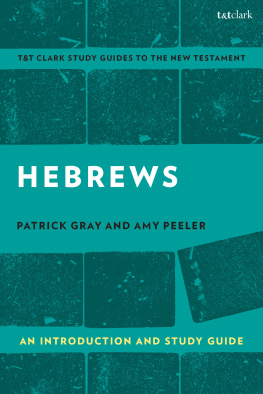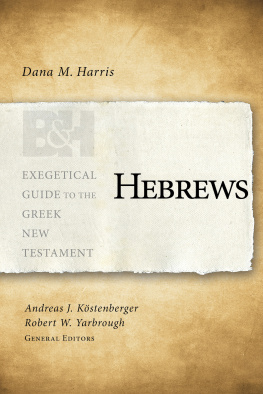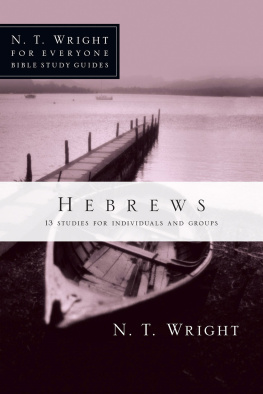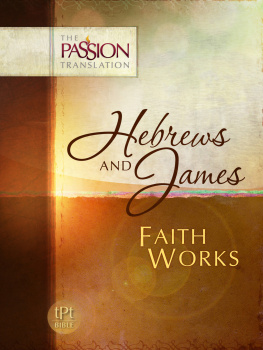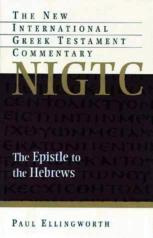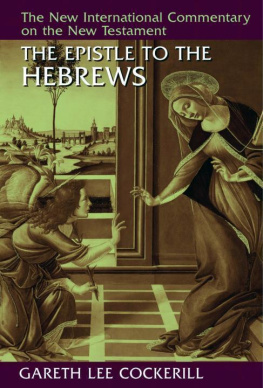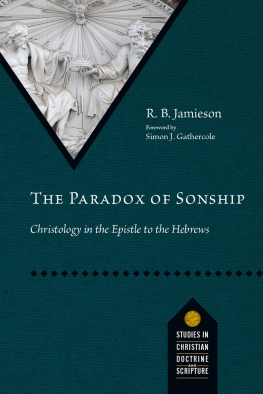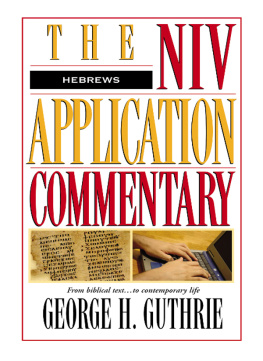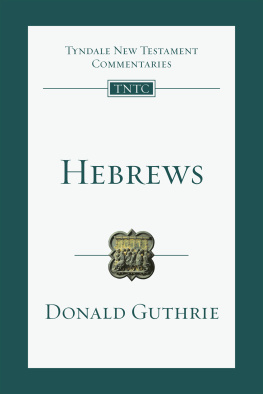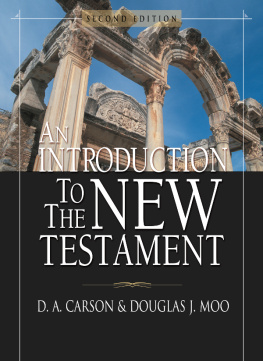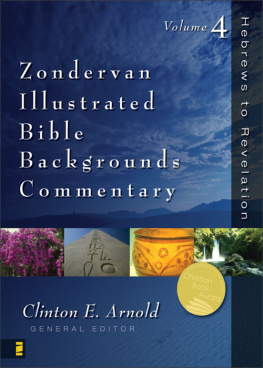Hebrews
T&T Clark Study Guides to the New Testament
Series Editor
Tat-siong Benny Liew, College of the Holy Cross, USA
Other titles in the series include:
1&2 Thessalonians: An Introduction and Study Guide
1 Peter: An Introduction and Study Guide
2 Corinthians: An Introduction and Study Guide
Colossians: An Introduction and Study Guide
Ephesians: An Introduction and Study Guide
Galatians: An Introduction and Study Guide
James: An Introduction and Study Guide
John: An Introduction and Study Guide
Luke: An Introduction and Study Guide
Mark: An Introduction and Study Guide
Matthew: An Introduction and Study Guide
Philemon: An Introduction and Study Guide
Philippians: An Introduction and Study Guide
Romans: An Introduction and Study Guide
The Letters of Jude and Second Peter: An Introduction and Study Guide
T&T Clark Study Guides to the Old Testament:
1 & 2 Samuel: An Introduction and Study Guide
1 & 2 Kings: An Introduction and Study Guide
Ecclesiastes: An Introduction and Study Guide
Exodus: An Introduction and Study Guide
Ezra-Nehemiah: An Introduction and Study Guide
Leviticus: An Introduction and Study Guide
Jeremiah: An Introduction and Study Guide
Job: An Introduction and Study Guide
Joshua: An Introduction and Study Guide
Psalms: An Introduction and Study Guide
Song of Songs: An Introduction and Study Guide
Numbers: An Introduction and Study Guide
Hebrews
An Introduction and Study Guide
Patrick Gray and Amy Peeler

Contents
This volume offers a concise introduction to one of the most daunting texts in the New Testament. The Letter (or Sermon?) to the Hebrews has inspired many readers with its encomium or tribute to faith, troubled others with its hard sayings on the impossibility of a second repentance, and perplexed still others with its exegetical assumptions and operations drawn from a cultural matrix that is largely alien to modern sensibilities. Long thought to be Paul, the anonymous author of Hebrews exhibits points of continuity with the apostle and other New Testament writers in the letters (or sermons) vision of life in the light of the crucified Messiah, but one also finds distinctive perspectives in such areas as Christology, eschatology, and atonement.
The introduction surveys the salient historical, social, and rhetorical factors to be considered in the interpretation of Hebrews. Chapter 1 provides a brief commentary on the text. Chapter 2 discusses recent scholarship on the teaching of Hebrews as it relates to the Holy Spirit. Chapter 3 examines the history of interpretation of Hebrews from antiquity to the present, with special attention to its theological, liturgical, and cultural legacy outside the precincts of the academy. Questions for further study are included to aid groups or individuals who wish to engage more deeply with one of the most original Christian writers of the first century.
References to God as Father (with accompanying male pronouns) appear in our discussion of Hebrews. We employ this language to follow the terminology employed by this ancient author whose letter refers to God as Father twice (1:5; 12:9). Feminist critiques of such language rightly name the incorrect assumption that it often imports, namely, that God is male. New Testament texts as well as Christian traditions have rejected this assumption; instead, many affirm that God is spirit. For this author of Hebrews, we argue that paternal language captures the personal nature of God and the intimate relationship this God has with Jesus and with those who are followers of Jesus, especially as they relate to the issues of education and inheritance closely related to the family in the authors sociocultural context. We wish for this language not to be a distraction but to point toward the text and to the realities this language communicated for the author and the community to whom the author was writing.
Chapter outline
Who wrote the Letter to the Hebrews? When was it written? What can be known about its intended audience? What prompted its composition, and what did the author hope to achieve? Is it, in fact, a letter, or does it belong to some other genre? These and other introductory questions will be discussed before proceeding to a more detailed treatment of the text in the following chapter.
Listening to a symphony without knowing the name of the composer or gazing at a work of art without knowing who painted it can be a disorienting experience. In much the same way, reading a text without knowing who wrote it can likewise be discomfiting. If only for psychological reasons, then, the earnest efforts to identify the author of the Letter to the Hebrews from antiquity to the present come as little surprise. The list of candidates is perhaps longer for Hebrews than for any other book in the New Testament. Patristic interpreters put forth a number of names, with the apostle Paul receiving the most attention (see below). As soon as his name emerges, it is clear that other figures had already been associated with the letter (Eusebius, Hist. eccl . 3:38; 6:14, 25). Clement of Alexandria late in the second century claims that Luke was responsible for translating into Greek a Hebrew original produced by Paul. Origen similarly remarks that the thoughts might be those of Paul but the language is not, mentioning that Clement of Rome had been proposed as the author but concluding that God knows who actually wrote it. Tertullian ( Pud . 20) quotes Hebrews and attributes it to Barnabas, who had also been credited with writing a second-century epistle that touches on some of the same themes as Hebrews.
These few names mentioned as possibilities by patristic writers are each discussed in relation to Paul, either on stylistic grounds or in connection with the passing reference to Timothy in Heb. 13:23. Yet Marcion does not include it among Pauls letters, and though it is commonly accepted in the Eastern church, doubts as to its Pauline authorship are widespread in the West from an early date. Its delayed inclusion in the canon was in no small measure a function of these lingering doubts. Athanasius lists Hebrews among Pauls letters in his Thirty-Ninth Festal Letter of 367, but as late as 397 the Synod of Carthage reflects uncertainty in speaking of the thirteen epistles of the Apostle Paul and only then adding one epistle to the Hebrews, by the same.
Reformation-era critics shift their focus from style to content. Luther could not square the apparent prohibition of repentance for post-baptismal sin in Heb. 6:4-6 with Pauls emphasis on Gods grace extended to sinners. Erasmus and Calvin likewise sense differences between the teachings of Paul and of Hebrews but do not share Luthers reservations about the latters place in the canon. (Luther places Hebrews alongside James, Jude, and Revelation at the end of his 1522 edition of the German New Testament, indicating his theological qualms about its status.) On the Catholic side, the Council of Trent in 1546 includes Hebrews among the Pauline letters and affirms its status as Scripture. The King James Version of 1611 follows suit in attributing it to Paul in the title.
The view that Paul wrote Hebrews enjoys very little support among modern scholars. To be sure, Hebrews and Pauls writings share a number of concerns. Both authors envision Jesus as having a role in creation before obediently humbling himself and taking on human nature (Heb. 1:2-3; 2:14-17; cf. Rom. 8:3; 1 Cor. 8:6; 2 Cor. 4:4; Gal. 4:4; Phil. 2:6-8). They emphasize faith in the relationship between God and humanity and cite Abraham as an exemplar of how this relationship may unfold (Heb. 11:11-12, 17-19; Rom. 4:1-25). They refer to a number of the same biblical texts in making their arguments (e.g., Deut. 32:35 in Rom. 12:19 and Heb. 10:30; Psalm 8 in 1 Cor. 15:27 and Heb. 2:6-9; Hab. 2:4 in Rom. 1:17; Gal. 3:11; and Heb. 10:38). And it is worth noting that Hebrews never circulated independently of the Pauline corpus in the surviving manuscript tradition.

